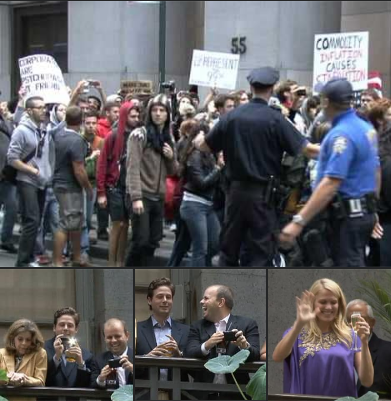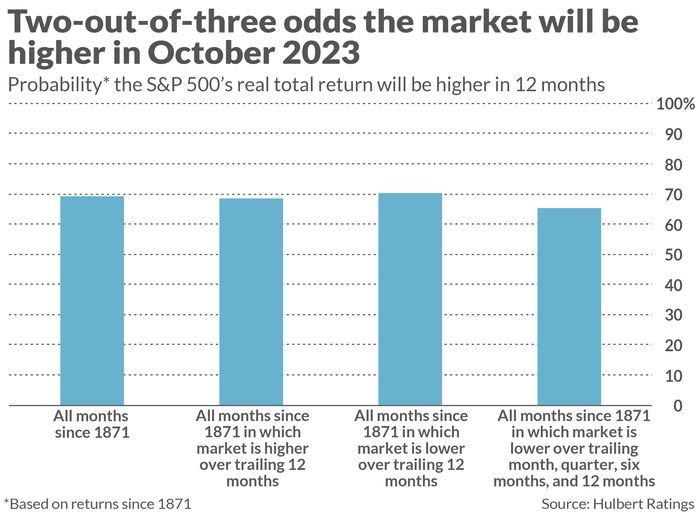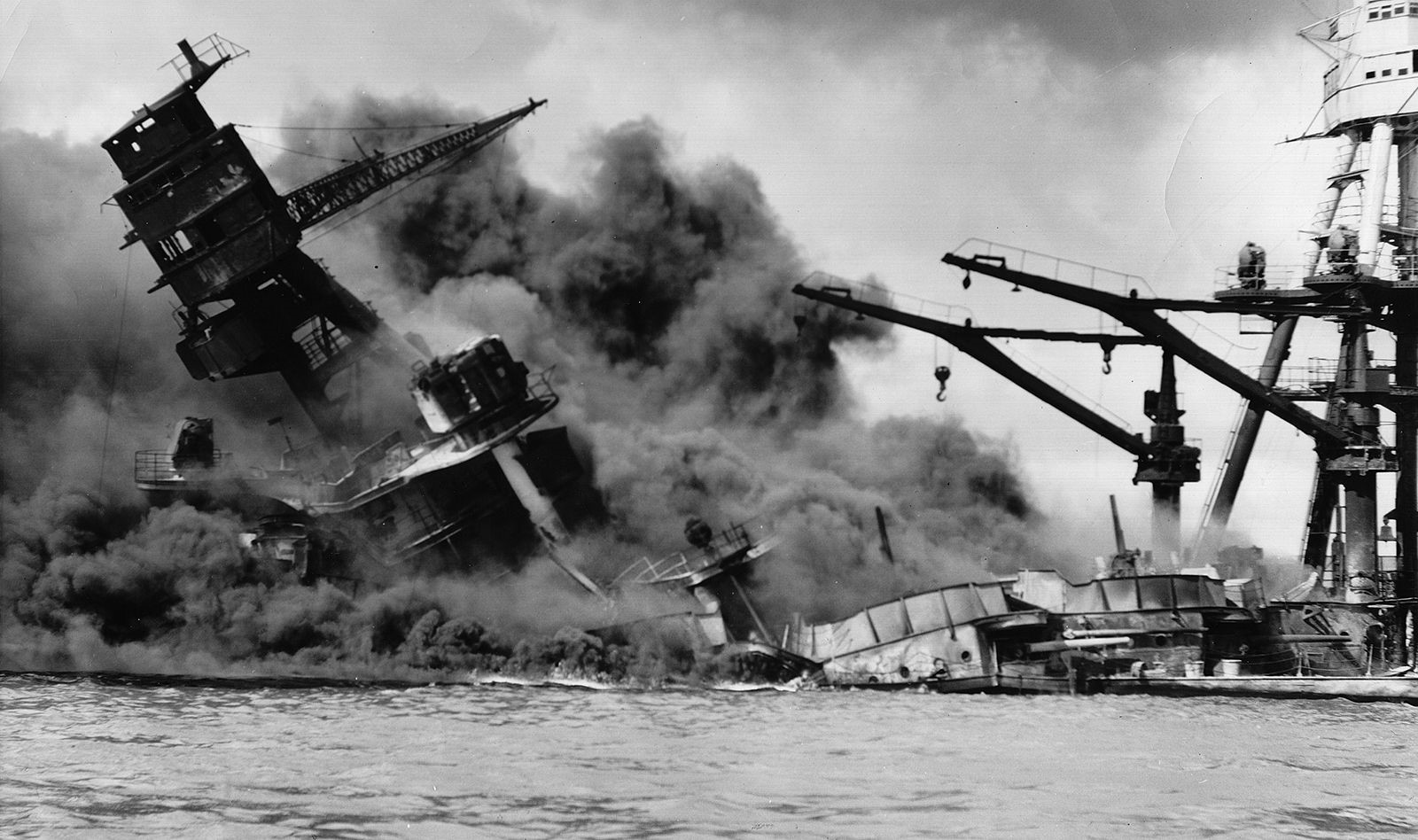Do you remember what happened in 2007–2008?
The subprime mortgage crisis was unfolding.
Millions of Americans were losing their jobs.
Millions of Americans were losing their homes.
Lehman Brothers. Fannie Mae. Freddie Mac. Famous institutions were experiencing a violent financial meltdown.
Indeed, this was the worst downturn since the Great Depression. And here’s one of the most powerful images to emerge from that time period:

Class warfare or psychological bias? Source: Reddit
Main Street versus Wall Street.
The peasants versus the aristocrats.
Desperation versus arrogance.
These pictures (which are actually from 2011) seem to suggest a contradiction. The poorer people who are suffering from economic grief are protesting at the ground level — even while the richer people are looking down on them from the balcony of a high-end restaurant.
The symbolism is compelling.
Is this an accurate depiction of class warfare? One group of people pitted against another? Or…are we just injecting our own subconscious bias on some random photographs?
Maybe. Maybe not.
But look past the optics. Look past the drama. One striking fact remains: all that turmoil actually set the stage for something remarkable. It launched us into the longest bull run since the Second World War. The S&P 500 index soared over 500% from March 2009 to November 2021.
Now, if you are sceptical of the wealth gap, you might question all this. How is it possible that millions of lives were ruined and stocks still pushed forward and climbed? How is that acceptable? How is that even moral?
But…rein in your emotions. Strip out your biases. You will be left with one important conclusion: Main Street is not Wall Street.
Main Street is the economy of the present.
Wall Street is the economy of the future.
As it stands, the market is neither moral nor immoral. It is amoral.
Also, the market is neither liberal nor conversative. It is agnostic.
So, regardless of what you choose to think about the market, it will chart its own path forward. In fact, it must.
Scottish philosopher Adam Smith first talked about the ‘invisible hand’ in the 18th century. The dynamic push-and-pull equilibrium of supply and demand.
The concept remains stunningly relevant, even now in the 21st century.
In fact, it’s happening as we speak.
The ghost of 2022 versus the baby of 2023
Covid. Money printing. Inflation.
It’s easy enough to connect the dots.
As my colleague Simon Angelo has explained, 2022 was the year where we had to pay the piper back for all the easy money that we enjoyed in 2020 and 2021.
The drawdown in asset prices was painful but necessary.
So…what does 2023 hold for us? What lies on the horizon ahead?
Well, analyst Tom Lee from Fundstrat has an interesting observation:
In the 19 instances of a negative S&P 500 index return year since 1950, over half of those years were followed by the large-cap index gaining more than 20%, according to Fundstrat’s data. Only two of those years were followed by a flat year with a return ranging from 5% to negative 5%.
“Stocks are 5X more likely to rise 20% than be flat, and more than half of the instances are over 20% gains,” said Lee in a Friday note.
Moreover, these probabilities are far higher than compared to typical years. In all 73 years since 1950, there is only a 27% chance for the S&P 500 to finish with an over 20% gain, compared to 53% odds in post-negative years.
While past performance is no indicator of the future, the chances that we will experience a market rejuvenation are better than you might think.
Certainly, money doesn’t sleep. Money seeks growth. Money seeks yield.
There’s more persuasive historical evidence to back this up.
Robert Shiller from Yale University has studied the performance of the market over the past 150 years. He looked closely at all 12-month periods during that time. What he found was intriguing: the market tends to rise 69.2% of the time.
In fact, the odds here are two out of three.

Source: MarketWatch
But are you still sceptical about the future? Are you feeling pessimistic?
Well, for argument’s sake, let’s just say you’re a glass-half-empty person. You’re looking at the state of the world today — and you’re seeing nothing but bad news and more bad news.
So…in light of that…how do the odds look? Still favourable? Well, surprisingly, yes.
For example, let’s look at what happened during World War II. It’s the most devastating, most traumatic conflict of all time. Up to 80 million people perished. Entire swathes of the planet were reduced to rubble.
And yet…here’s how Fortune Magazine describes Wall Street’s performance during that time:
The Dow increased 10% on the first day of trading after Hitler invaded Poland in 1939. When the attack on Pearl Harbor occurred, stocks fell 2.9% but regained those losses in one month. From 1939 until the end of the war in late 1945, the Dow saw increases of 50%, more than 7% per year.

December 7, 1941. A day of infamy at Pearl Harbor. But stocks shrugged it off and marched on with courage. Source: Britannica
Extraordinary, isn’t it?
Once again, what most people miss is that Wall Street is not connected in real time to Main Street.
The truth is that the stock market is forward-looking. It’s actually pricing in all available data about the next 12 months to 18 months — sometimes more — and it’s reflecting them accordingly.
This is why, throughout 2022, we saw a drawdown of stock values on Wall Street — even though the employment data on Main Street remained strong and there was no recession at that point.
It’s actually the future fear that stocks are reacting to. Future fear of inflationary pressure. Future fear of rising interest rates.
But once all that is priced in, the market must move on.
Our opportunity for you
Do you choose fear? Or do you choose courage?
The contrast has never been clearer. The long-term opportunity has never been more urgent.
Here at Vistafolio, we are already preparing for the next bull run. We are helping our Eligible and Wholesale Clients regain control of their destiny by building a roadmap to financial freedom.
At the moment, we have our eye on investment targets in Australasia, Europe, and North America. We are especially keen on resilient sectors like infrastructure, energy, and commodities.
It’s about protecting your wealth. Growing your wealth. Gaining passive income.
So, are you looking for guidance? For direction?
Come talk to us. We’re now offering an initial free consult for Eligible and Wholesale Clients. We’d love to hear more about your financial goals and dreams.
🌎 Click here to register your interest today.
Regards,
John Ling
Analyst, Wealth Morning
(This article is general in nature and should not be construed as any financial or investment advice. Vistafolio services are for Wholesale or Eligible investors as defined in the Financial Markets Conduct Act 2013. Please request a free consultation if you would like to discuss your eligibility.)





John is the Chief Investment Officer at Wealth Morning. His responsibilities include trading, client service, and compliance. He is an experienced investor and portfolio manager, trading both on his own account and assisting with high net-worth clients. In addition to contributing financial and geopolitical articles to this site, John is a bestselling author in his own right. His international thrillers have appeared on the USA Today and Amazon bestseller lists.